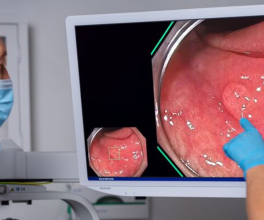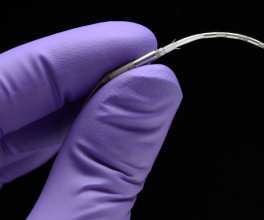
Top Five Topics about Uterine Fibroids that Every Woman Should Know
Did you know up to 80% of women are expected to have fibroids in their lifetime?1 Not sure what a fibroid is?2
July is Fibroid Awareness Month and the perfect time for women to become educated on uterine fibroids, which may be a cause of infertility.2 In a very small number of women, uterine fibroids may be determined to be cancerous or pre-cancerous, particularly in women over the age of 50.3 Here are 5 of the most important topics each woman needs to know about fibroids so they can take the necessary and proactive steps to keep their reproductive system healthy.
1. What are fibroids?
Uterine fibroids are benign growths in the uterus. Fibroids can range in size, number, and location inside the uterus. Some fibroids are very small causing no noticeable symptoms or discomfort.4 Others can be quite large causing pain, bleeding, and heavy pressure in the abdomen.4 Fibroids are most common in women between the ages 30-40 years old and through menopause.2 Most fibroids are benign, but there is a small, but increased risk that fibroids can contain pre-cancerous or cancerous cells, especially in women over the age of 50.3 Although uncertainty remains in exactly was causes fibroids to form, doctors believe hormones and genetics are contributing factors.3
2. Common Symptoms
A common symptom of uterine fibroids is heavy menstrual bleeding.4 Other types of abnormal bleeding that can indicate fibroids include bleeding or spotting between periods, bleeding or spotting after sex, menstrual cycles that are longer than 38 days or shorter than 24 days, “irregular” periods in which cycle length varies by more than 7–9 days, or bleeding after menopause.5 Other symptoms of fibroids that are unrelated to the menstrual cycle can be seen as constipation, frequent urination, backache, or leg pains.6 Despite this long list of possible symptoms, not all women who have fibroids experience symptoms. Abnormal uterine bleeding can also be unrelated to fibroids such as the presence of uterine polyps, endometriosis, or endometrial cancer.
3. Important Fibroid Statistics
Olympus conducted a survey on the platform Survey Monkey to learn what women know about uterine fibroids, abnormal uterine bleeding, and treatment options for these conditions. 943 women participated in the survey between the ages of 18 to 64. In this survey, approximately 20% of the women reported being diagnosed with uterine fibroids, and roughly half of the women surveyed had either experienced abnormal bleeding or were actually uncertain if they had, the latter pointing to the lack of understanding on how abnormal uterine bleeding is defined.
Within the group of women who reported that they had experienced heavy bleeding, roughly one-third of them waited at least one year and others up to six years before seeking any treatment, noting either that their symptoms were annoying but not serious and/or that their physicians did not think there was any reason to be concerned. This delay in seeking care could result in a missed diagnosis of fibroids, endometriosis, polyps, or endometrial cancer that can worsen over time. Women who are experiencing symptoms should actively speak to their gynecologist about their symptoms, as many treatment options are available including minimally invasive surgeries to improve their quality of life.
4. Treatment Options
There are a variety of treatment options for these conditions, including medical therapies depending on the severity. Minimally invasive (laparoscopic) hysterectomies are a common way to eliminate fibroids by removing the uterus entirely.7 For other women still seeking to become pregnant, laparoscopic myomectomy can be performed to remove the fibroids, leaving the uterus intact.8 Minimally invasive procedures result in lower complications, can be done on an outpatient basis, and can afford women a faster recovery.7 Yet, in the survey performed, nearly 30% of women did not know whether laparoscopic or open surgery was preferable.
5. The Reality of the Patient Experience
The patient experience is unique for everyone. Some women have no symptoms of their fibroids and some have extreme cases, but it is good to see different perspectives of the patient experience. One woman willing to share her story with Olympus, Kate, explains her personal difficulty navigating her symptoms of fibroids. “There were a good five months when I would have long stretches of such heavy bleeding,” says Kate “…that I would have to be in the bathroom constantly away from my patients.” Being a medical interpreter for hearing impaired patients who need surgery, Kate knew that she had to get a handle on this heavy bleeding so she could do her job to the best of her ability. When Kate went to her doctor, they discovered that she had extremely large fibroids and her uterus was three times the normal size. Because of the identification of these symptoms and speaking with her doctor, Kate underwent a minimally invasive procedure called a “laparoscopic fibroidectomy” during which her fibroids were successfully removed, helping her get back to her best and doing the job she loves with no interruptions from fibroid symptoms.9 For an additional patient story regarding fibroids, visit truetolife.com/blog/patient-experience/weighing-options.
Warning: There are risks associated with this type of procedure. Uterine tissue may contain unsuspected cancer. The use of laparoscopic power morcellators during fibroid surgery may spread cancer, and decrease the long-term survival of patients. For more information on risks visit: medical.olympusamerica.com/products/contained-tissue-extraction-system.
Throughout the rest of July, we encourage you to continue educating yourself about uterine fibroids and feel reassured that talking to your doctor is the best first step to ensure a healthy body and reproductive system!





